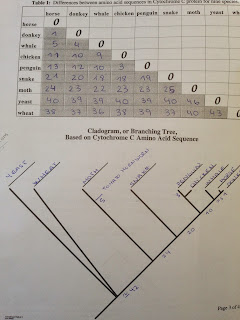Practica de biologia : Activitat enzimàtica de la catalasa en diferents teixits animal i
vegetals.
Material:
- -Diferents teixits animals
- -Patata pastanaga i tomàquet
- -Cinc tubs d’assaig
- -Termòmetre
- -Bisturí
- -Tisores
- -Aigua oxigenada (2ml per tub)
- -Aigua destil·lada (5ml per tub)
- -Pipeta
Protocol:
Tallem dos
trossos de patata, pastanaga i tomàquet
amb la mateixa mida i pes
També tallem
un tros de fetge i cor de la mateixa mida i pes
Ho posem
en 5 tubs
- - 1er patata + 5ml d’aigua destil·lada
- -2n tomàquet + 5ml d’aigua destil·lada
- -3r pastanaga + 5ml d’aigua destil·lada
- -4r fetge+5ml d’aigua destil·lada
- -5è cor+5ml d’aigua destil·lada
Afegirem
aigua oxigenada i marquem l’alçada de les bombolles
Preguntes
Variable
dependent i independent ? La variable dependent es la que nosaltres modifiquem
es a dir la concentració de cada substancia
i el que afegim la independent es l’alçada de les bombolles
Problema
a investigar? La activitat de la catalasa en els diferents teixits animals i
vegetals
Explica
els resultats: La activitat de la catalasa era mes gran en el tros de fetge perquè
es on es duen a terme mes reaccions enzimàtiques el cor
també han reaccionat pero no amb tanta intensitat com el fetge ja que la seva
activitat no estan elevada. En els teixits vegetals l’aigua oxigenada no reaccionat
tant com en els vegetals ja que la seva activitat es molt menor.
|
Teixit
|
Alçada bombolles (mm)
|
|
Patata
|
65 (mm)
|
|
Tomàquet
|
62 (mm)
|
|
pastanaga
|
63 (mm)
|
|
Fetge
|
90 (mm)
|
|
cor
|
75 (mm)
|
Experiment
2 : Com afectarà diferents factors a l’activitat enzimàtica
- 1r tub tros de teixit
animal a temperatura ambient
- 2n tub de teixit
animal amb 10ml d’HCL al 10%
- 3r tub tros de teixit
animal congelat
- 4t tub tros de teixit
animal bullit
- 5è tub tros de teixit
animal submergit en una dissolució saturada de NaCl
Afegirem 2ml de aigua
oxigenada i notarem l’alçada de les bombolles
|
Tub
|
Alçada de les bombolles (mm)
|
|
1
|
65 mm
|
|
2
|
45 mm
|
|
3
|
60 mm
|
|
4
|
47 mm
|
|
5
|
46 mm
|
Preguntes:
Variable dependent i
independent ?
-Dependent :es la que
estem investigant per tan es l’alçada de les bombolles
-Independent: Es el
tractament que em fet en cada tub
Problema que es vol
investigar ? Com actua la activitat de la catalasa en diferents factors
Explicació dels
resultats :
En el tub que em bullit
i el que em afegit HCl no han reaccionat per que s’han desnaturalitzat es adir
els factors que mes afecten a la activitat de la catalasa son el Ph i la
temperatura , el tub amb una concentració saturada de NaCl i el que estava congelat
han presentat una activitat mes alta que els altres dos , en canvi el tub que
no hem manipulat a reaccionat mes i es el que ens a servit per compara.
Quina es la funció de la catalasa en els teixits animals o vegetals? On es troba aquet enzim? La seva funció es descompassar l’aigua oxigenada en hidrogen i oxigen. Es troba en els peroxisomes.
Perquè quant ens fem una
ferida ens posem aigua oxigenada? Per eliminar els bacteris anaeròbics ja que
no poden sobreviure si tenen oxigen









.JPG)